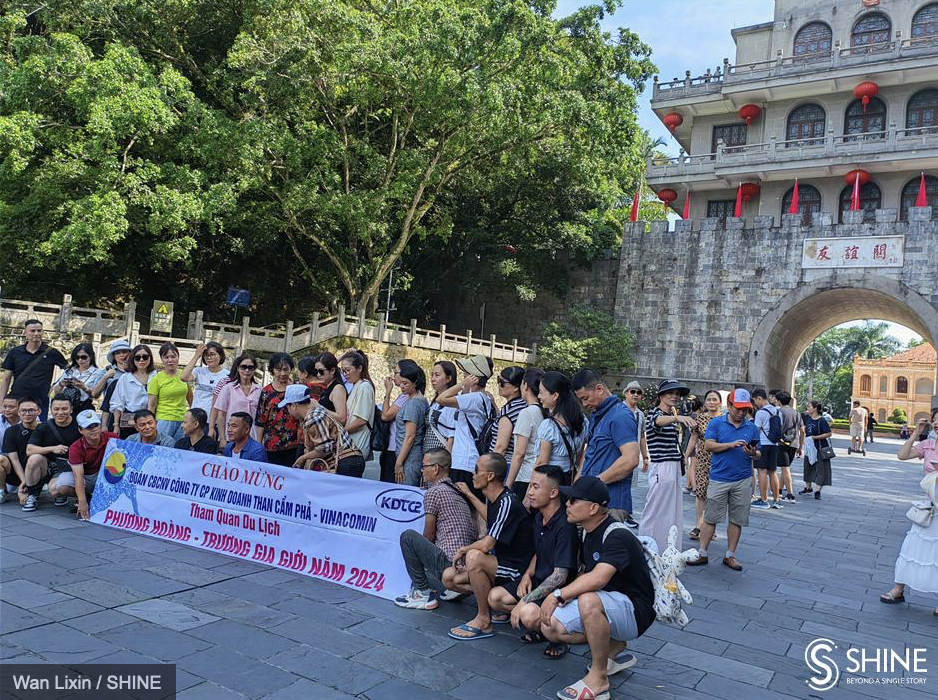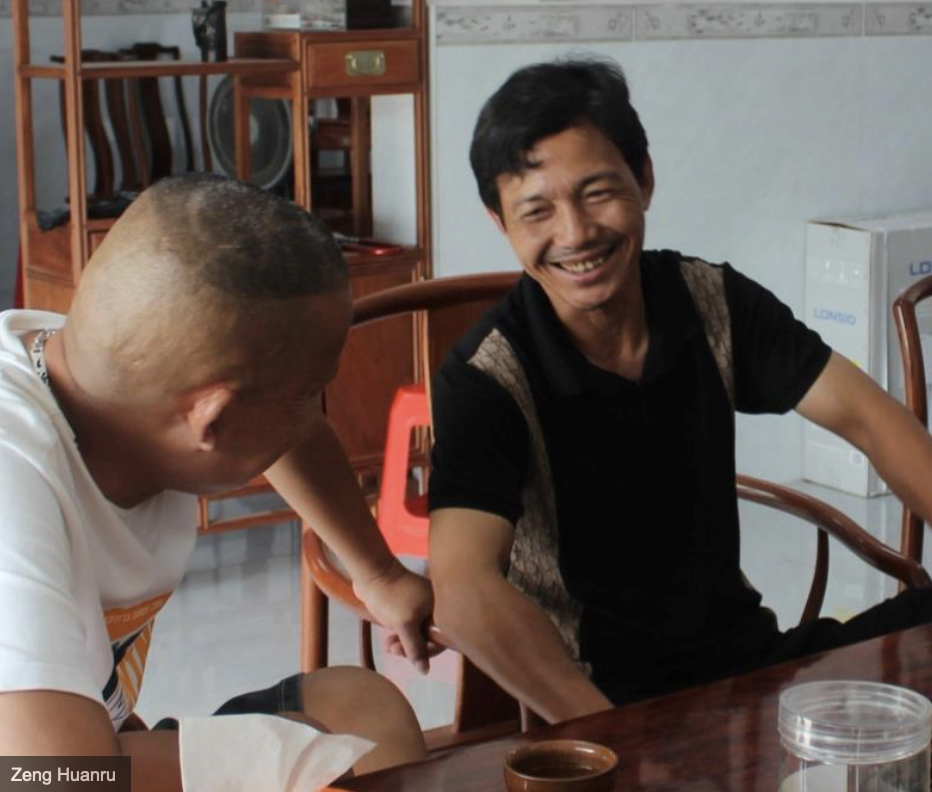During our recent trip to south China's Guangxi Zhuang Autonomous Region, we rode from its capital Nanning to Pingxiang, better known for the Friendship Pass about 15 kilometers southwest of the city. It afforded us a view of undulating green hills like picture postcards.
It was also a journey revealing how systematic border trade between China and Vietnam benefits residents of nearby villages.
The "border residents mutual market," or bianmin hushi, used to be a vibrant business activity in Pingxiang, a county-level city with a population of 129,800 permanent residents. Locals say that during the heydays of hushi, the actual population doubled due to the influx of migrants.

Vietnamese tourists pose for a picture at the Friendship Pass in Pingxiang.
"My parents would exchange cloth and portable recorders, radios or flashlights in exchange for copper or farm produce from Vietnam. Since we can understand each other in our dialect, it was just like visiting a neighboring village," said Zhang Shanghua, 42, speaking of the go-go 1990s, in Nongyao, one of the four such markets during that time.
The market carried on by individuals in a piecemeal manner, with goods poled on shoulders or carried by hands, halted during the pandemic, and has not yet fully recovered, added Zhang, pointing to the rows of shanty houses now lying vacant in Nongyao.
Today, electronic appliances from China are still much in demand in Vietnam, and like his parents, Zhang continues to engage in mutual trade – as a livestreaming host.
Having learned to speak Vietnamese in the southeast Asian country, Zhang has been hosting cross-border livestreaming e-commerce since March 2022.
Last year, during one livestreaming session for electronic appliances on Shopee, Zhang's sales topped 300,000 yuan (US$42,800).
He was so successful that he launched a livestreaming business of his own. Shanyuan E-commerce Co opened this June, with about eight employees from both China and Vietnam. Technically still a villager, with a rural hukou, Zhang's fate testifies to how fortune favors the ambitious, even in Guangxi, whose residents' per capita income of 29,514 yuan in 2023 ranked 25th among the 31 provinces or autonomous regions in China.

A livestreaming hostess tries to sell cosmetics to Thai audiences in Nanning.
Zhang did not agree with the observation that a Vietnamese-speaking Chinese host trying to pitch a product to Vietnamese audiences would be at a disadvantage compared with a native host naturally acquainted with the psyche and customs of consumers.
"Since we are familiar with the functions of these appliances, our demonstration would appear to be more authentic, and more persuasive," Zhang explained.
To a degree, maybe. Some of the electric appliances have, by necessity, undergone modifications to adapt to local conditions. For instance, some electric fans and electric cookers are equipped with rechargeable battery because local electric supply is not so dependable.
As a matter of fact, Guangxi plays a significant role in supplementing power supply in the neighboring country. Last summer, the Chinese region transmitted 110 kilowatts of electricity to Vietnam.
Leveraging its strategic location near ASEAN (Association of Southeast Asian Nations) countries, Guangxi has been vigorously expanding its cross-border e-commerce. In the first quarter, the region's cross-border e-commerce import and export value reached 6.66 billion yuan, an increase of 5.1 percent year-on-year.
When local cadres observe that Guangxi residents are not xenophobic, it is clearly not an overstatement. From a very early age, the forefathers here were known to have traveled far and wide, outside the country, in search of livelihood in southeast Asia.
Their entrepreneurship is manifested not just in individuals such as Zhang, but also evinced in the business acumen of village cadres, like those in Pingxiang's Nanshan Village, particularly in their innovative rehabilitation of the village "cooperative."
Endowed with a 97-kilometer border with Vietnam, Pingxiang is like a wedge-like protrusion, culminating in the Friendship Pass, which can be traced back to 2,000 years, with its name changing six times, culminating in its current title since 1965.
Four million tons of cargo went through this pass in 2023, with approximately 18.6 percent being imported fruits, accounting for about half of Chinese fruit imports.
In an interview at the Pingxiang Logistics Park in the China-ASEAN Free Trade Zone in late July, villager cadres, while plying us with gongfu tea, an ubiquitous local ritual, explained how the village cooperative works.
According to a border trade management circular issued by the customs administration in 1996, those eligible for 'border resident' status would be eligible to trade up to 8,000 yuan worth of goods every day, duty free. Border residents are those living within 20 kilometers of the border, while those living within 3 kilometers are "first-line border residents" or "borderline residents."
"In the past, hushi was more about piecemeal, retail trade carried on shoulders, or by hand. It has now been replaced by the cooperative scheme," noted Liu Qiang, deputy general manager of Pingxiang International Trade Development Co.
In this border trade co-op, the individual villager's entitlement to 8,000-yuan trade is transferred to the co-op, enabling it to engage in bulk cargo trade, which becomes more competitive in view of the savings in custom duties.
"A truckload of dragon fruit, for example, would require the quota of about 20 border residents. In the case of a truckload of durian, which is more valuable, it would need about 100 quotas. A truckload of durian would save about 50,000 yuan in customs duty," Liu pointed out.
Half of the earnings is shared by the co-op members as dividend once every quarter, and 20 percent is owned collectively, with the rest 30 percent billed as operating expenditure. The collective income would be used on village infrastructure, rewarding those villagers who have been admitted to colleges, or in sending seasonal gifts to unattended elderly villagers.
Liang Lilong, the village Party secretary, now operates two of the four co-ops in the village, which are chiefly engaged in importing mango and jackfruit from Vietnam, and their subsequent distribution.

Vũ Văn Hải (right) drove about 1,000 kilometers from Haiphong, Vietnam, to the parking lot in Nanshan Village, with a truck full of durians.
"This scheme spares border residents the hassle of having to go through customs declaration themselves, with each of them standing to gain 1,000-2,000 yuan in dividend annually," said Liang.
Apparently, border trade co-op is just one means of increasing village income. The village's exploitation of the reserved field – land allocated as compensation to the village for future development after the state has requisitioned the collective field, typically 10-15 percent of the requisitioned.
In Nanshan Village, some of the over 100 mu (6.67 hectares) of such land has been turned into two parking lots, as part of the Nanshan Collective Economy Industrial Park.
Chinese goods heading to Vietnam need to go through customs clearance on the Chinese side, and then queue up for going through the pass. This process can take anywhere from one day to several days, depending on the situation, hence the need for parking space.
In the second parking lot, launched on February 17, we encountered a Vietnamese driver named Vũ Văn Hải, 45, who had transported a truck of durians unloaded by local Nanshan villagers.
He had driven about 1,000 kilometers from Haiphong, Vietnam, for 15 hours. He had been making such trips for about four years, earning a monthly salary of 4,000-6,000 yuan, which is a relatively high income in his country.
This parking lot is chiefly for drivers like him, who would return to Vietnam while leaving their truck here for cargo transfer to Chinese trucks, as Vietnamese can stay only one day with a border pass due to current regulations.
Loading and unloading trucks also provide useful employment for Nanshan villagers. At the village office, Huang Haiyuan, 40, also a member of the co-op, is engaged in such odd jobs.
"Before the launch of the co-ops, I carried goods at the hushi market, which was tough. Now I stand to gain 1,000 yuan in dividend sharing annually. Last month I also made 7,000 yuan by unloading goods here," said Huang.
The income is already higher than what they could hope to make by working as migrants, mostly in neighboring Guangdong Province.
From the early days of bianmin hushi to the current e-commerce and co-op schemes, mutual trade is being facilitated differently, yet the benefits delivered to border residents remain substantial, in spite of the changing times.
The authors are Si Yuting, Zeng Huanru and Wan Lixin.Diao Wencong and Zhou Xinyi also contributed to the article. Si Yuting, Zeng Huanru, Diao Wencong and Zhou Xinyi are MA students from the School of Journalism and Communication, Shanghai International Studies University.

 |Hongkou Campus|550 Dalian Road (W), Shanghai 200083, China |Songjiang Campus|1550 Wenxiang Road, Shanghai 201620, China
|Hongkou Campus|550 Dalian Road (W), Shanghai 200083, China |Songjiang Campus|1550 Wenxiang Road, Shanghai 201620, China